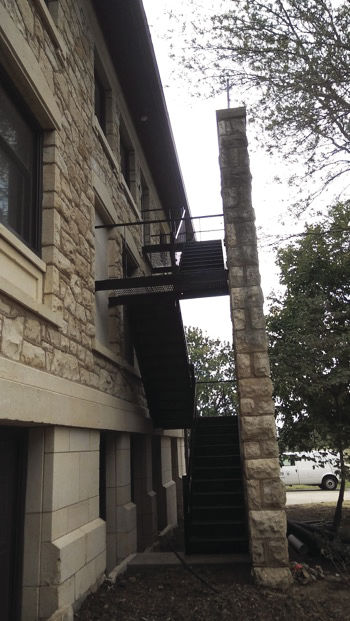Washburn seeks to be fully ADA compliant
October 3, 2017
Following the 2010 amendments of laws that govern disability accessibility and action taken by WSGA last year to audit the university, students and faculty at Washburn are left wondering about the details of the transition into compliance with the law.
The transition plan itself outlines what Washburn intends to do in the coming years to make the campus more user-friendly for everyone, but many feel that despite the planned coming modifications, there is still more to be done beyond what is required by law.
The American Disability Act or ADA as it came to be known, is a relatively new act. Following the examples recently set by women and minorities, policy was pushed forward in the 1973 Rehabilitation Act to try to remove discriminatory policies in the workplace.
However, since this only covered institutions that receive federal funding, the more powerful ADA was drawn up in the early 90’s to cover private institutions and workplaces. Title III is the section of the act that applies directly to Washburn University, listing out requirements that every public university is bound to.
One of the biggest struggles, besides budget, surrounding the continuing issue of bringing Washburn completely up to date are the grey areas such as Carnegie Hall. With its steep steps and aged architecture, wheelchair entrance to many of its classrooms is impossible. However, it is also protected as a historical building, meaning that no alterations can be done.
“[Carnegie] is an old building. We try to move classes if there is no wheelchair access,” said Pam Foster, equal opportunities director at Washburn. “Most all of [the buildings], we upgrade them as we can.”
To be compliant with the law, one must prove that there is a transition plan in place to help the students on campus, but as parts of campus such as the Henderson elevators break down, items on the plan can get shuffled around, causing those affected to wonder if troublesome areas will be fixed in the foreseeable future.
To help shed light on the issue, WSGA passed two separate resolutions last year: first, make the campus more accessible for students and second, create an accessibility tour, which would essentially be an audit of Washburn done by the student government to investigate areas of Washburn deemed difficult.
“With the audit last year, we had set that up through student government,” said the Speaker Pro Tempore for Student Senate junior Traevor McPherson. “We had a resolution passed and I worked with a number of student government members, faculty members and students with an abbreviated list of ADA requirements. There was a number of issues that we hit. Everyone who went on that tour had an ‘aha’ moment when we were shocked to find out that it might be that way for someone on campus.”
Jasper Shrake, senior music major, is one of the students that helped push the need for an audit, went into the specifics of the audit.
“[WSGA] got a group together, they went around and looked for access to buildings, services and bathrooms, the football field, Garvey,” Shrake said. “Every bathroom in Henderson is ADA compliant. There are logistical issues that are ADA compliant but hard to use. Morgan is a mess. When only one entrance is usable, it is difficult because in inclement weather, it is hard to use…the biggest issue is parking and making sure there is an accessible route to making sure there is a route from the parking lot to an entrance. ADA only requires one entrance per parking lot.”
The results of the audit were worked into Washburn’s transition plan, the document declaring what projects are possible in the projected budget for the next few years.
“I think we’ve been proactive,” said Vice President of Administration Jim Martin. “We had a transition plan in place before they were calling it a transition plan. Last year, we did the library, Lincoln Hall and Petro restrooms… It’s a dynamic process. We comply with the law. Some of the things from the audit are not scheduled yet, some are scheduled in 2017, 2018 [and] 2019.”
Rich Connell, director of the facilities department, brought up two other areas of concern that he would fix.
“Two areas have manifested: the parking spots by Stoffer Science and Moore bowl… [the] key component is reasonable accommodations,” Connell said. “We have to show that we are working on it.”
Martin also outlined general safety procedures for the rest of campus in case of emergency.
“WU Police Department is the first line of defense, then social services,” Martin said. “We have people who are trained, largely the police. When alarms go off, they assess. There are people in the LLC and Lincoln. They are meant for [people with] disabilities.”
The outlined procedures, however, are what worry Shrake.
“Maybe someone is deaf or mute,” Shrake said. “You are requiring them to make a social contract with someone for their life. That is absurdly dangerous. The fact is that the Village has ADA compliant dorms, but no ADA compliant tornado shelter. They have a tornado shelter downstairs. You basically have to climb in your bathtub and hope for the best.”
Shrake would prefer for the ADA to have stricter regulations over all parts of campus.
“I would tighten up regulations on title three (private entities),” Shrake said. “They can do whatever they want. I would try to legitimize a governing body at the state level to actually hunt down people instead of waiting until someone files a complaint. People with disabilities already have enough to deal with.”
On the topic for action to be taken beyond the law, McPherson is in agreement.
“If the students are saying that this path, even though it meets the legal requirements, is hard to use, steps should be taken to alleviate those barriers,” McPherson said. “When we help other students we help everybody.”



